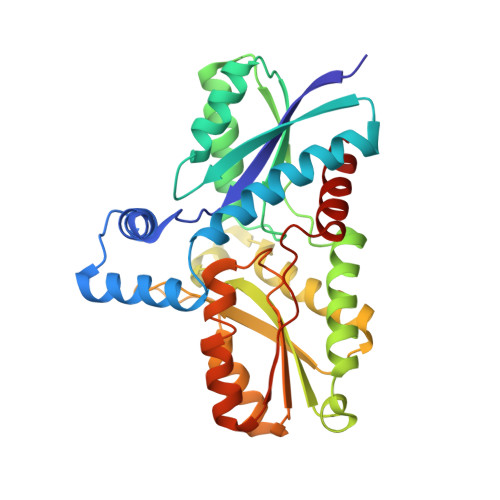Metallation of the Transition-state Inhibitor N-methyl Mesoporphyrin by Ferrochelatase: Implications for the Catalytic Reaction Mechanism.
Shipovskov, S., Karlberg, T., Fodje, M., Hansson, M.D., Ferreira, G.C., Hansson, M., Reimann, C.T., Al-Karadaghi, S.(2005) J Mol Biol 352: 1081-1090
- PubMed: 16140324
- DOI: https://doi.org/10.1016/j.jmb.2005.08.002
- Primary Citation of Related Structures:
2AC2, 2AC4 - PubMed Abstract:
Insertion of metals into various tetrapyrroles is catalysed by a group of enzymes called chelatases, e.g. nickel, cobalt, magnesium and ferro-chelatase. It has been proposed that catalytic metallation includes distorting the porphyrin substrate by the enzyme towards a transition state-like geometry in which at least one of the pyrrole rings will be available for metal chelation. Here, we present a study of metal insertion into the transition-state inhibitor of protoporphyrin IX ferrochelatase, N-methyl mesoporphyrin (N-MeMP), by time-resolved crystallography and mass spectrometry with and without the presence of ferrochelatase. The results show that metallation of N-MeMP has a very limited effect on the conformation of the residues that participate in porphyrin and metal binding. These findings support theoretical data, which indicate that product release is controlled largely by the strain created by metal insertion into the distorted porphyrin. The results suggest that, similar to non-catalytic metallation of N-MeMP, the ferrochelatase-assisted metallation depends on the ligand exchange rate for the respective metal. Moreover, ferrochelatase catalyses insertion of Cu(II) and Zn(II) into N-MeMP with a rate that is about 20 times faster than non-enzymatic metallation in solution, suggesting that the catalytic strategy of ferrochelatase includes a stage of acceleration of the rate of ligand exchange for the metal substrate. The greater efficiency of N-MeMP metallation by Cu(II), as compared to Zn(II), contrasts with the K(m) values for Zn(II) (17 microM) and Cu(II) (170 microM) obtained for metallation of protoporphyrin IX. We suggest that this difference in metal specificity depends on the type of distortion imposed by the enzyme on protoporphyrin IX, which is different from the intrinsic non-planar distortion of N-MeMP. A mechanism of control of metal specificity by porphyrin distortion may be general for different chelatases, and may have common features with the mechanism of metal specificity in crown ethers.
Organizational Affiliation:
Department of Molecular Biophysics, Centre for Chemistry and Chemical Engineering, Lund University, P.O. Box 124, SE-221 00 Lund, Sweden.















